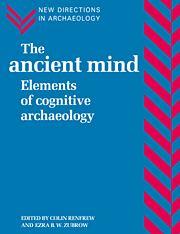Book contents
- Frontmatter
- Contents
- List of figures
- List of tables
- List of contributors
- Preface
- PART I INTRODUCTION
- PART II THE INTERDISCIPLINARY UNDERPINNING
- PART III APPROACHES TO CULT PRACTICE AND TRANSCENDENTAL BELIEF SYSTEMS
- 6 The archaeology of religion
- 7 Ancient Zapotec ritual and religion: an application of the direct historical approach
- 8 The meaning of death: funerary beliefs and the prehistorian
- 9 Prehistoric cognition and the science of archaeology
- PART IV PREHISTORIC CONCEPTIONS OF SPACE AND TIME
- PART V THE MATERIAL BASIS OF COGNITIVE INFERENCE: TECHNOLOGY
- PART VI THE MATERIAL BASIS OF COGNITIVE INFERENCE: WRITING SYSTEMS
- PART VII CONCLUSION
- Index
7 - Ancient Zapotec ritual and religion: an application of the direct historical approach
Published online by Cambridge University Press: 03 December 2009
- Frontmatter
- Contents
- List of figures
- List of tables
- List of contributors
- Preface
- PART I INTRODUCTION
- PART II THE INTERDISCIPLINARY UNDERPINNING
- PART III APPROACHES TO CULT PRACTICE AND TRANSCENDENTAL BELIEF SYSTEMS
- 6 The archaeology of religion
- 7 Ancient Zapotec ritual and religion: an application of the direct historical approach
- 8 The meaning of death: funerary beliefs and the prehistorian
- 9 Prehistoric cognition and the science of archaeology
- PART IV PREHISTORIC CONCEPTIONS OF SPACE AND TIME
- PART V THE MATERIAL BASIS OF COGNITIVE INFERENCE: TECHNOLOGY
- PART VI THE MATERIAL BASIS OF COGNITIVE INFERENCE: WRITING SYSTEMS
- PART VII CONCLUSION
- Index
Summary
This chapter is dedicated to José Luis Lorenzo, whose thoughtful advice in 1979 led to the discovery of the temple sequence below Structure 13 at San José Mogote
We see today a growing interest in cognitive approaches to archaeology, a genuine desire to reach back for the mental templates that underlie human behaviour. While this interest is surely commendable, we should guard against two possible negative outcomes. One such outcome would be the conversion of cognitive archaeology into a fad or a narrow speciality that ignores all other aspects of prehistory. The other would be the delusion that our search for the ancient mind is a recent advance for which our generation is solely responsible.
To avoid the first pitfall, we prefer to speak not of ‘cognitive archaeology’ but rather of ‘holistic archaeology’, a discipline in which cognitive variables would be given equal weight with ecological, economic and sociopolitical variables. As far back as 1976 we called for ‘a framework for analysis which is neither a mindless ecology nor a glorification of mind divorced from the land’ (Flannery and Marcus 1976a: 383).
To avoid the second pitfall, we remind ourselves that many previous generations of archaeologists were just as interested in topics such as ideology, cosmology, iconography and religion (e.g. Caso 1945, 1958; Thompson 1950, 1966, 1970, 1973). Consider, for example, the brilliant writings of Frankfort et al. (1946) on the mind of ancient Egypt and Mesopotamia nearly half a century ago.
- Type
- Chapter
- Information
- The Ancient MindElements of Cognitive Archaeology, pp. 55 - 74Publisher: Cambridge University PressPrint publication year: 1994
- 50
- Cited by

